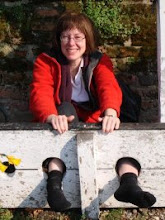I recently bought Havig's Classic English Medallion Style Quilts. Something bothered me - it took a while to realise what it was - all the quilts in the book had Bindings. Now if you have looked at the antique quilts on this blog you will know that British quilts nearly always have a knife edge. No where in that book is any information on the traditional knife edge. The quilts just don't look right to my eye - the binding immediately marks them out as not British.
So here are some photos of how to make the knife edge - not difficult, but very neat looking - and- no extra fabric is needed.
 My whole cloth quilts are carefully pre-marked - and usually have a line around the edge of the quilt. First, sew along this line - being careful to turn the corner neatly. Use your walking foot.
My whole cloth quilts are carefully pre-marked - and usually have a line around the edge of the quilt. First, sew along this line - being careful to turn the corner neatly. Use your walking foot.
Next, trim off extra fabric and wadding - I trimmed it down to an inch beyond the sewn line - 1/4" fabric turn under leaving a 3/4" edge. Use your rotary ruler and take your time. Measure twice and cut once....

Next, I bent the fabric back and trimmed the extra wadding away with scissors- here, about 1/4". You don't have to be too careful about this as any extra can be pushed in during the next stage. But do be careful not to cut into the front or back of the quilt.
 Then, using the ruler again, I turned under 1/4" of the top fabric to leave an edge of 3/4" - pin in place carefully.
Then, using the ruler again, I turned under 1/4" of the top fabric to leave an edge of 3/4" - pin in place carefully. Turn to the back and using the same pin turn under the back to match the front and pin again.
Turn to the back and using the same pin turn under the back to match the front and pin again. Judging from my antique quilts this next step is not entirely necessary, but it does make a nice edge - using a whip stitch neatly sew back and front together. Take special care at the corners to make a neat job.
Judging from my antique quilts this next step is not entirely necessary, but it does make a nice edge - using a whip stitch neatly sew back and front together. Take special care at the corners to make a neat job.
Again this step is not de rigeur - many of my quilts have only one line of machine stitching. However, with my first wholecloth quilt one of the FOQ judges said that the edge was "too puffy" so since then I have always added a second or even third line of stitching. This makes the edge neat looking and firm. Darn in any thread tails.


How secure is a knife edge compared to a bound edge, and if you sew the double line by hand, do you end up having to go through a lot of layers?
ReplyDeleteThanks for the tutorial Pippa..very interesting...I'll give it a try one of these days.
ReplyDeleteBest Wishes
Kay in Scotland
Thanks for the tutorial - I haven't tried a traditional British knife edging. Can you tell me how it stands up to wear compared with a bound edge?
ReplyDeleteThank you for this tutorial......I will be using this on my next quilt instead of binding....I really like the look of it.....
ReplyDeleteThat's interesting that the actual quilting is done by hand but the knife edge is sewn by machine. Thanks.
ReplyDeleteThis edge seems fairly durable, to judge by my old quilts. The stitching was sometimes done by hand, especially in Wales, but in the Northeast, it was most often done by machine. This makes the edge firm. I also think that people were practical - and proud of their sewing machines which were a major purchase. The WI frowned on machine sewn edges and insisted on hand sewn edges in their exhibitions. I imagine that it would be difficult to sew by hand as you have to make sure to catch the turn under, if not whip stitching the edge. Pippa
ReplyDeleteThank you for posting the tutorial, Pippa! I do a knife edge on all my quilts - but I do it completely by hand and close the quilt with a row of running stitches very near the outside edge. It fits perfectly to a traditional wholecloth.
ReplyDeleteThank you for the wonderful tut on the knife edge binding. I'm using a knife edge to finish some of my Grandmother's orphan Lone Star blocks that I'm making into table toppers.
ReplyDeleteI linked to your post in my blog ... thank you again for sharing your technique.
http://busybeeno16.blogspot.com/2013/06/new-life-for-my-grandmothers-orphan.html
The quilt looks like it is hand quilted, I'm curious why you would machine stitch the knife edge?
ReplyDeleteHi, the thought was, that the machine sewn edge was very sturdy and hard wearing. Also, women were very proud of their sewing machine, which of course was a major purchase. Generally, North Country quilts had a machined edge whereas Welsh quilts had a hand sewn edge, it comes down to personal preference today....
ReplyDelete